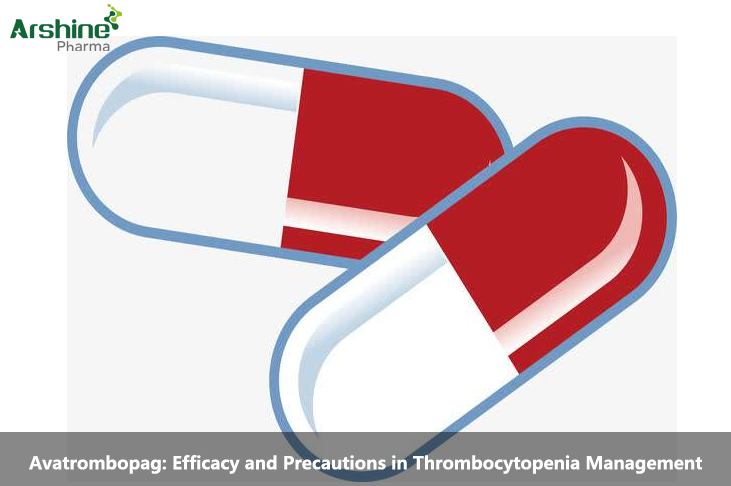
Introduction: Avatrombopag, also known as avatrombopag maleate, is an oral thrombopoietin receptor agonist used in the management of thrombocytopenia (low platelet count). Thrombocytopenia can arise due to various medical conditions, including chronic liver disease, immune thrombocytopenia (ITP), and chemotherapy-induced thrombocytopenia. Avatrombopag's efficacy lies in its ability to stimulate platelet production, thereby increasing platelet counts and reducing the risk of bleeding. This article provides a comprehensive review of avatrombopag's efficacy, mechanisms of action, and precautions to ensure its safe and effective use in patients with thrombocytopenia.
-
Mechanisms of Action: Avatrombopag is a thrombopoietin receptor agonist that selectively interacts with the thrombopoietin receptor, c-Mpl, on megakaryocytes in the bone marrow. This interaction triggers intracellular signaling pathways that promote megakaryocyte proliferation and differentiation. As megakaryocytes mature, they release platelets into the bloodstream, leading to an increase in platelet counts.
-
Efficacy in Thrombocytopenia Associated with Chronic Liver Disease: Avatrombopag has demonstrated significant efficacy in raising platelet counts in patients with thrombocytopenia associated with chronic liver disease. In clinical trials, avatrombopag effectively increased platelet counts and reduced the need for platelet transfusions in patients with chronic liver disease undergoing invasive procedures. This effect is especially crucial in patients with cirrhosis, as they are at a higher risk of bleeding complications during medical interventions.
-
Immune Thrombocytopenia (ITP) Management: Avatrombopag has emerged as a promising treatment option for immune thrombocytopenia (ITP), an autoimmune disorder characterized by low platelet counts due to platelet destruction by the immune system. Clinical trials have shown that avatrombopag effectively raises platelet counts in patients with chronic ITP who have not responded to other treatments. It can be used as a second-line therapy in patients for whom corticosteroids or other immunosuppressive agents have been ineffective.
-
Chemotherapy-Induced Thrombocytopenia Prevention: Avatrombopag has been investigated for its potential in preventing chemotherapy-induced thrombocytopenia in patients undergoing chemotherapy for cancer treatment. By increasing platelet production, avatrombopag may reduce the severity and duration of chemotherapy-induced thrombocytopenia, minimizing the need for platelet transfusions and improving patients' overall outcomes during cancer treatment.
-
Dosage Considerations: The appropriate dosage of avatrombopag depends on the underlying condition and patient characteristics. Healthcare professionals should determine the starting dose carefully, considering the patient's baseline platelet count and the degree of thrombocytopenia. Periodic platelet count monitoring is necessary during treatment to adjust the dosage as needed and ensure that the platelet count remains within the desired therapeutic range.
-
Precautions and Contraindications: a. Liver Function Monitoring: Since avatrombopag is metabolized in the liver, it is essential to monitor liver function regularly during treatment, especially in patients with preexisting liver disease. Elevated liver enzymes and bilirubin levels may occur, and treatment should be interrupted or discontinued if severe hepatic impairment is detected.
b. Thromboembolic Events: Thromboembolic events, including deep vein thrombosis (DVT) and pulmonary embolism (PE), have been reported in patients receiving avatrombopag. Patients with an increased risk of thromboembolic events, such as those with a history of DVT or PE, should be closely monitored during treatment. The benefits of avatrombopag should be carefully weighed against the potential risk of thromboembolic complications in these patients.
c. Pregnancy and Breastfeeding: The safety of avatrombopag use during pregnancy and breastfeeding has not been established. Animal studies have shown potential adverse effects on fetal development. Avatrombopag should be avoided in pregnant and breastfeeding women unless the potential benefits outweigh the risks. Female patients of childbearing age should be advised to use effective contraception during treatment with avatrombopag.
d. Pediatric Use: The safety and efficacy of avatrombopag in pediatric populations have not been fully established. Its use in children and adolescents should be carefully considered, and further research is needed to determine its safety and appropriate dosing in this population.
-
Drug Interactions: Avatrombopag may interact with certain medications, affecting its pharmacokinetics or the response to other drugs. Caution should be exercised when co-administering avatrombopag with drugs that are metabolized by cytochrome P450 enzymes, as it may alter their plasma concentrations. Healthcare providers should review the patient's medication profile and consider potential drug interactions before initiating avatrombopag treatment.
-
Adverse Effects: Common adverse effects of avatrombopag include headache, nausea, fatigue, and diarrhea. Transient increases in liver enzymes may also occur, but they are usually reversible upon discontinuation of the medication. Thromboembolic events and hepatotoxicity are rare but potentially severe adverse effects that require immediate medical attention.
-
Monitoring and Follow-Up: Regular monitoring of platelet counts, liver function, and possible adverse effects is essential during avatrombopag treatment. Close communication with the patient and careful evaluation of treatment response can help optimize dosing and minimize the risk of adverse events.
Conclusion: Avatrombopag is an effective and promising pharmacological option for managing thrombocytopenia associated with chronic liver disease, immune thrombocytopenia (ITP), and chemotherapy-induced thrombocytopenia. Its mechanism of action, specifically stimulating platelet production, offers valuable benefits in increasing platelet counts and reducing the risk of bleeding. However, precautions should be taken in patients with liver impairment, those at increased risk of thromboembolic events, and during pregnancy and breastfeeding. Healthcare providers should closely monitor patients' platelet counts, liver function, and potential adverse effects to ensure the safe and effective use of avatrombopag in the management of thrombocytopenia. Continuous research and post-marketing surveillance efforts will further enhance our understanding of avatrombopag's efficacy and safety, optimizing its therapeutic role in patients with thrombocytopenia.
